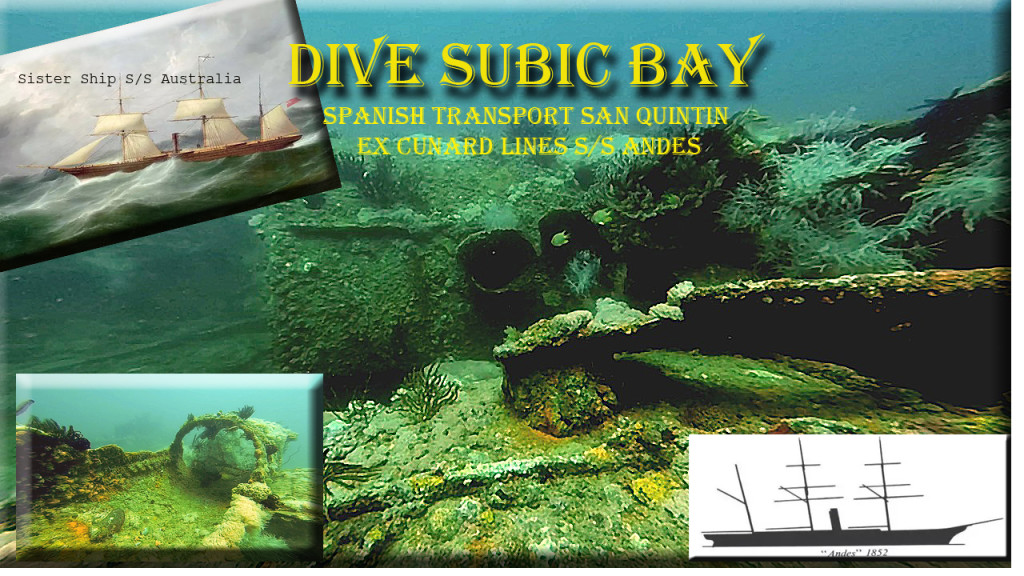For decades, divers at Subic Bay have called the San Quintîn wreck a gun boat. Time and storms has not been kind to this ship scuttled by the Spanish Navy in 1898. Most of her has been flattened or is hidden in the sand. Still, the bow, stern and boilers are mostly intact. Recently I started to try to find a better description of the San Quintîn to improve what we know and possibly find a photograph or one of a similar vessel. In the process, I found some items that did not fit with this wreck being a gun boat. Over time, I decided to start researching based just on the name and the reason/date it was sunk. After a couple hundreds hours of research, I was able to find an authority reference to the sinking of the Transport San Quintîn. Searching records for a transport lead to some amazing discoveries about this ship. The most amazing is that she started life as a mail steamer for none other than the world famous Cunard Lines, on the Liverpool to New York route.
History of the Armed Transport San Quintîn
In 1850, the British and North American Royal Mail Steam Packet Company ordered four identical iron screw Passenger/cargo vessels from the Scottish ship builder William Denny & Brothers. They were the Andes, Alps, Australia and Sydney. The ships were listed as 1275 grt/866 nrt , the length of 236.6 feet (72 meters), beam of 33.2 feet (10.1 meters) and depth of 24 feet (7.3 meters). The ships were mail ships. These were basically passenger ships that also operated under a contract to transport mail. The ships were design to carry 62 passengers in first class and 122 in second class.
In 1850,the British and North American Royal Mail Steam Packet Company changed their name to Cunard Lines. The Cunard Lines took possession of the S/S Andes on August 18, 1852. The S/S Andre made its maiden voyage to New York sailing from Liverpool on December 8, 1852, however, problems with it propulsion system forced them to return to port. The problems were corrected and the ship arrive in New York on Christmas Eve. The Ship continued to sail that route until 1854. In 1854, with the out break of the Crimean War, the British government leased the S/S Andes and the S/S Alps. The two ships were initial used as troop transports and later the S/S Andes was used as a hospital ship. After the war, they returned to service with Cunard Lines.
In 1859, the Spanish government bought both the S/S Andes and the S/S Alps. The S/S Andes was renamed to the San Quintîn and the S/S Alps renamed to Mandingo. The San Quintîn’s initial role seems to be transport as well as a mail ship.
Note on names: The Andes is often shown as Andes (1852). This is to keep it from being confused with two later mail ships named Andes in the 1900s. San Quintîn is also seen spelled as San Quentin.
While there is not a definitive history of the San Quintîn, there are many historical references to her. She shows in dispatches from Cuba in 1862 for her role in recovering wounded soldiers from Vera Cruz and returning with supplies. In the mid 1880s she shows in the history of Micronesia as a passenger ship, mail ship and governments transport. In the early 1890s she in involved with a number of military campaigns in the Philippines. A fuller history of the ship can be found on my San Quintîn page.
On March 15 1898, Admiral Montojo of the Spanish Navy ordered her sunk to block one of the entrances to Subic Bay, where she still is today. She is an excellent wreck for beginning divers and a wreck that advance divers also find interesting. Recreational divers have about 20 possible dive sites mostly wrecks and technical divers at least another dozen in Subic Bay all within 20 minutes of any of the dive centers.
Information about diving at Subic Bay can be found at Johan’s Beach and Dive Resort website.






